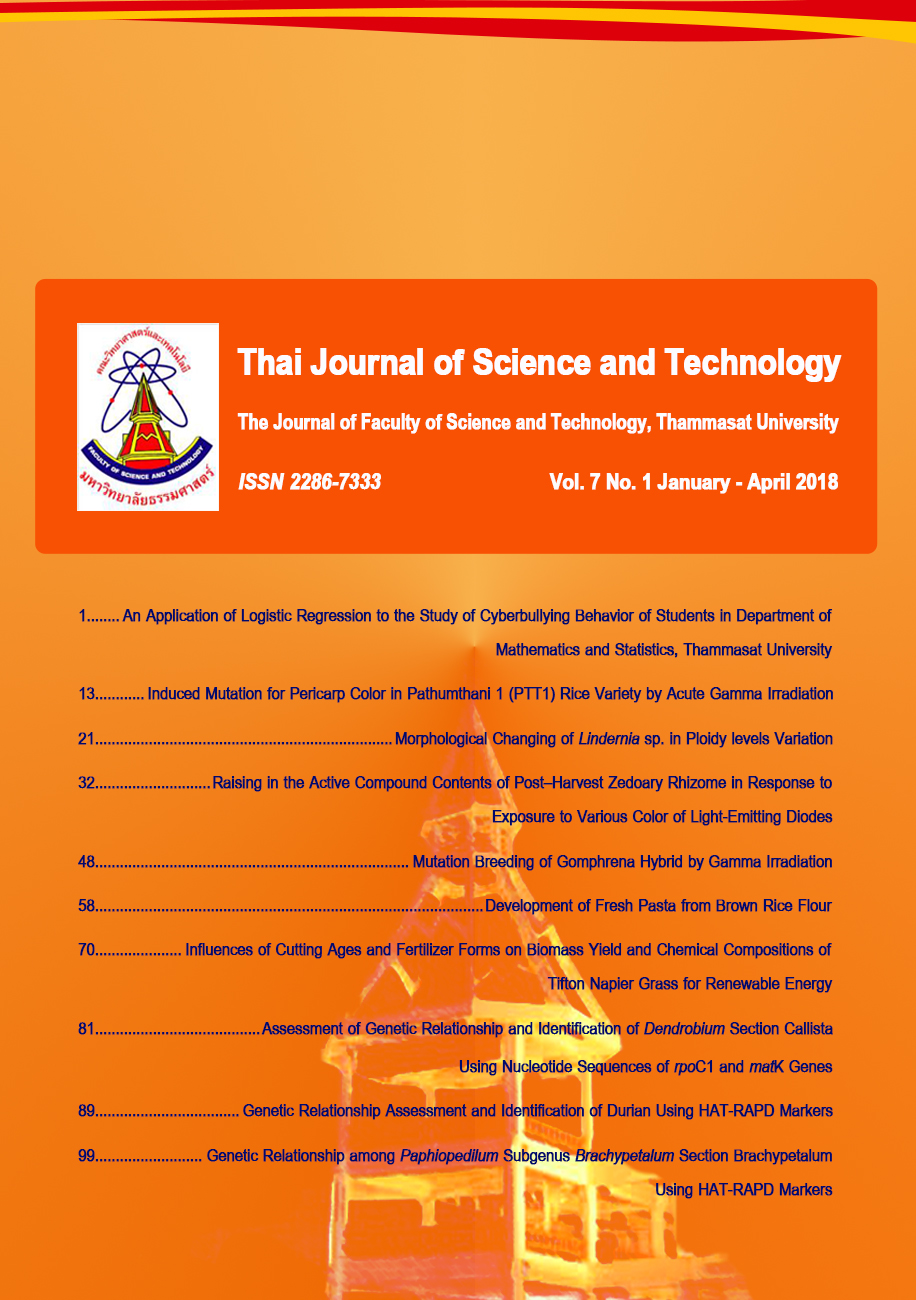อิทธิพลของอายุการตัดและรูปแบบปุ๋ยที่มีต่อผลผลิตชีวมวลและองค์ประกอบทางเคมีของหญ้าเนเปียร์ทิฟตันเพื่อใช้เป็นพลังงานทดแทน
Main Article Content
Abstract
บทคัดย่อ
ศึกษาอิทธิพลของอายุการตัดและรูปแบบปุ๋ยที่มีต่อผลผลิตชีวมวลและองค์ประกอบทางเคมีของหญ้า เนเปียร์ทิฟตันเพื่อใช้เป็นพลังงานทดแทน แผนการทดลองแบบ Split-plot in RCBD จำนวน 4 ซ้ำ ประกอบด้วยปัจจัยหลัก คือ อายุการตัดที่ 120 วัน (A1), 150 วัน (A2) และ 180 วัน (A3) ปัจจัยรอง คือ การให้ปุ๋ย 4 รูปแบบ ได้แก่ ปุ๋ยยูเรีย อัตรา 36.8 กิโลกรัมไนโตรเจน/ไร่/ปี (T1), ปุ๋ยยูเรียผสมปุ๋ยคอกและใบกระถิน (ปุ๋ยยูเรีย อัตรา 18.4 กิโลกรัมไนโตรเจน/ไร่/ปี และปุ๋ยคอกผสมใบกระถิน (30 : 70, %w/w) อัตรา 18.4 กิโลกรัมไนโตรเจน/ไร่/ปี) (T2), ปุ๋ยคอกผสมใบกระถิน (30 : 70, %w/w) อัตรา 36.8 กิโลกรัมไนโตรเจน/ไร่/ปี (T3) และไม่ให้ปุ๋ยไนโตรเจน (T4) ผลการทดลองพบว่าผลผลิตน้ำหนักสดและแห้งภายใต้รูปแบบปุ๋ยทั้ง 4 นั้น ทรีทเมนต์ที่ได้รับปุ๋ยไนโตรเจน ได้แก่ ปุ๋ยยูเรีย (T1), ปุ๋ยยูเรียผสมปุ๋ยคอกผสมใบกระถิน (T2) และปุ๋ยอินทรีย์; ปุ๋ยคอกผสมใบกระถิน (T3) มีค่าสูงกว่า (P<0.05) ไม่ให้ปุ๋ยไนโตรเจน (T4) ปริมาณองค์ประกอบไฮโดรเจนของการตัดหญ้าเนเปียร์ที่อายุ 180 วัน (A3) ร่วมกับการได้รับปุ๋ยไนโตรเจนแบบ T1, T2 และ T3 มีค่าสูงกว่า (P<0.05) ทรีทเมนต์ที่เหลือ การตัดหญ้าเนเปียร์ที่อายุ 180 วัน (A3) ร่วมกับการใส่ปุ๋ยอินทรีย์ (T3) มีปริมาณองค์ประกอบไนโตรเจนและซัลเฟอร์สูงที่สุด (P<0.01) หญ้าเนเปียร์ที่อายุ 180 วัน (A3) ร่วมกับไม่ให้ปุ๋ยไนโตรเจน (T4) มีการสะสมคลอไรด์สูงที่สุด (P<0.01) และหญ้าเนเปียร์ที่อายุ 180 วัน (A3) ร่วมกับปุ๋ยอินทรีย์; ปุ๋ยคอกผสมใบกระถิน (T3) มีค่าพลังงานความร้อนสูงที่สุด (P<0.01) ซึ่งมีความเหมาะสมกับการนำไปใช้เป็นเชื้อเพลิงชีวมวลมากที่สุด
คำสำคัญ : อายุการตัด; รูปแบบปุ๋ย; ผลผลิตชีวมวล; หญ้าเนเปียร์; ค่าพลังงานความร้อน
Abstract
The objective of this experiment was to study the influences of cutting ages and fertilizer forms on biomass yield and chemical compositions on Tifton napier grass for renewable energy. By experiment, Split-plot in RCBD with four replications consists of 2 factors. Major factor was cutting ages, at 120 days (A1), 150 days (A2) and 180 days (A3). Minor factor included 4 fertilizer forms, i.e. urea fertilizer rate 36.8 kg.N/rai/year (T1), urea fertilizer mixed with cow manure andleucaena leaf (urea fertilizer rate 18.4 kg.N/rai/year and a mix of cow manure and leucaena leaf (30:70, %w/w) rate 18.4 kg.N/rai/year) (T2), cow manure mixed with leucaena leaf (30 : 70, %w/w) rate 36.8 kg.N/rai/year (T3) and non-nitrogen fertilizer (T4). The results of fresh and dry weight yield under four fertilizer forms showed that grasses under three nitrogen fertilizer treatments urea fertilizer, T1, T2 and T3, produced higher fresh and dry weight than those of T4 (P<0.05). In part of hydrogen content, cutting grass at 180 days combination with the nitrogen fertilizer treatments including T1, T2 and T3 had higher (P<0.05) hydrogen content than the rest treatments. For nitrogen and sulfur content, cutting grass at 180 days (A3) combination with cow manure mixed leucaena leaf (T3) achieved the highest nitrogen and sulfur percentages (P<0.01). Moreover, chloride content of grass with cutting grass at 180 days (A3) combination with non-nitrogen fertilizer (T4) gave the highest chloride percentage (P<0.01). Furthermore, napier grass under cutting age 180 days (A3) combination with cow manure mixed leucaena leaf (T3) gave the highest value of heating value (P<0.01) which is suitable for using as biomass fuel. (T3) gave the highest (P<0.01) value of heating value which is suitable for using as biomass fuel.
Keywords: cutting ages; fertilizer forms; biomass yield; napier grass; heating value
Article Details
บทความที่ได้รับการตีพิมพ์เป็นลิขสิทธิ์ของคณะวิทยาศาสตร์และเทคโนโลยี มหาวิทยาลัยธรรมศาสตร์ ข้อความที่ปรากฏในแต่ละเรื่องของวารสารเล่มนี้เป็นเพียงความเห็นส่วนตัวของผู้เขียน ไม่มีความเกี่ยวข้องกับคณะวิทยาศาสตร์และเทคโนโลยี หรือคณาจารย์ท่านอื่นในมหาวิทยาลัยธรรมศาสตร์ ผู้เขียนต้องยืนยันว่าความรับผิดชอบต่อทุกข้อความที่นำเสนอไว้ในบทความของตน หากมีข้อผิดพลาดหรือความไม่ถูกต้องใด ๆ
References
ยศนันท์ ศรีวิจารย์, กิตติ ศรีสะอาด และพีระยศ แข็งขัน, 2558, ผลของการใช้ปุ๋ยอินทรีย์ในนาข้าวต่อผลผลิตและความอุดมสมบูรณ์ดิน, J. Sci. Technol. MSU. 34: 514-522.
ลักขณา วุฒิปราชญ์อาไพ, กานดา นาคมณี, วีระพล พูนพิพัฒน์ และสุภาพร มนต์ชัยกุล, 2541, ผลของระยะปลูกที่มีต่อผลผลิตและส่วนประกอบทางเคมีของหญ้าเนเปียร์ 3 พันธุ์ ในพื้นที่จังหวัดชัยนาท, รายงานผลงานวิจัยประจำปี 2541, กองอาหารสัตว์ กรมปศุสัตว์ กระทรวงเกษตรและสหกรณ์, กรุงเทพฯ, 228 น.
สายัณห์ ทัดศรี, 2547, พืชอาหารสัตว์เขตร้อน, พิมพ์ครั้งที่ 1, สำนักพิมพ์มหาวิทยาลัยเกษตรศาสตร์, กรุงเทพฯ, 258 น.
สิริวัฒน์ ทองสวัสดิ์, 2554, ผลของการใช้ใบกระถินเป็นปุ๋ยพืชสดต่อผลผลิตและคุณค่าทางอาหารสัตว์ของหญ้าเนเปียร์พันธุ์ไต้หวันเอ 148 และรุควอน่า, วิทยานิพนธ์ปริญญาโท, มหาวิทยาลัยเกษตรศาสตร์, กรุงเทพฯ. 120 น.
Amarasekara, A.S., 2014, Handbook of Cellulosic Ethanol, 1st Ed., John Wiley & Sons, Inc., Texas.
Elizabeth, E.H., Peter, N. and Randall, P., 2011, Plant Biomass Conversion, 1st Ed., John Wiley & Sons, Inc., Oxford.
Kulasuwan, P., Thobunluepop, P., Tonmukayakul, N., Mani-in, P., Pongtip, A., Muangpan, J., ChangKaewmanee, J. and Vinijchevit, N., 2014, Effect of Seassonal and Cutting Interval of Napier Paek-Chong 1 on Growth Biomass and Biogas Productivity, Agric. Sci. J. 45(2)(Suppl.): 721-724.
Lewandoski, I. and Kicherer, A., 1997, Combustion quality of biomass practical relevance and weperiment to modify the biomass quality of Misanthus x giganteus, Eur. J. Agro. 6: 163-177.
Mohammed, I.Y., Abakr, Y.A., Kazi, F.K., Yusup, S., Alshareef, I. and Chin S.A., 2015, Comprehensive Characterization of Napier Grass as a Feedstock for Thermochemical Conversion, Energies. 8: 3403-3417.
Muangpan, J., Thobunluepop, P., Lertmongkol, S., Sarobol, E., Tonmukayakul, N., Kamwan, P.,
Pongtip, A. and Changkaewmanee, J., 2015, Effect of Nitrogen Fertilizer management on Growth and Biomass productivity of Napier Grasses, Agric. Sci. J. 46(3)(Suppl.) : 29-32.
Noi-uthai, S., Chotchutima, S., Tudsri, S., Sripichitt, P., Vaithanomsat, P., Suebsaiprom, W., Tonmukayakul, N. and Kongsila, P., 2014, Effect of cutting systems on biomass yield and biofuel quality of three napier grass cultivars for bioenergy, Agric. Sci. J. 45(2): 141-152.
Obernberger, I., Brunner, T. and Barnthaler, G., 2006, Chemical properties of solid biofuels significance and impact, Biom. Bioen. 30: 973-982.
Pandey, C.B., Sharma, D.K. and Bargali, S.S., 2006, Decomposition and nitrogen release from Leucaena leucocephala in central India, Trop. Ecology. 47(1): 149-151.
Prochnow, A., Hheiermann, M., Plochl, M., Amon, T. and Hobbs, P.J., 2009, Bioenergy from permanent grassland: A review 2, Combust. Biores. Technol. 100: 4945-4954.
Rengsirikul, K., Ishii, Y., Kangvansaichol, K., Sripichitt, P., Punsuvon, V., Vaithanomsat, P., Nakamanee, G. and Tudsri, S., 2013, Biomass Yield, Chemical Composition and Potential Ethanol Yields of 8 Cultivars of napier grass (Pennisetum purpureum Schu-mach.) Harvested 3-Monthly in Central Thailand, J. Sustain. Bioen. Syst. 3: 107-112.
Rocha, J.R.D.A.S.D.C., Machado, J.C., Carneiro, P.C.S., Carneiro, J.D.C., Resende, M.D.V., Pereira, A.V. and Carneiro, J.E.D.S., 2017, Elephant grass ecotypes for bioenergy production via direct combustion of biomass, Ind. Crops Prod. 95: 27-32.
Sungwan, W., Thobunluepop, P., Lertmongkol, S., Sarobol, E., Tonmukayakul, N., Thanya-vachirawit, K., Mani-in, P., Muangpan, J., Pongtip, A. and Changkaewmanee, J., 2014, Growth biomass productivity and nutrient uptake of napier Pak Chong 1 grass as affected by various nitrogen rates and cutting intervals, Agric. Sci. J. 45(2)(Suppl.): 593-596.
Tessema, M., Rahman, M. and Urquiaga, S., 2003, Effect of clipping interval and nitrogen fertilizer on oxalate content in pot-grown Napier grass, Trop. Grassl. 43: 73-78.
van Soest, P.J., Robertson, J.B. and Lewis, B.A., 1991, Methods for dietary fiber, neutral detergent fiber, and nonstarch polysaccharides in relation to animal nutrition, J. Dairy Sci. 74: 3583-3597.
Ward, C.Y. and Blaser, R.E., 1961, Carbo-hydrate food reserves and leaf area in regrowth of orchard grass, Crop Sci. 1: 366-374.


